Pongal is the first harvest festival of the year and the celebrations go on for four days. This is a sacred festival for Tamilians all over the world and the best celebrations take place in the state of Tamil Nadu. It falls on January 14 this year and the date pretty much remains constant over the years, sometimes it falls on January 15 as well. Pongal is also called Thai Pongal as the festival marks the beginning of the Tamil month Thai. This is considered to be an auspicious one and people celebrate it with much enthusiasm.
Thai month is believed to bring good luck by vanishing one’s problems away and therefore people look forward to celebrating Pongal. The harvest festival is celebrated over four days with each day having a different ritual. Here is how Pongal is celebrated in Tamil Nadu.
Pongal is a harvest festival and since rice is one of the main crops grown here, it is given due importance during the rituals. Even turmeric and sugarcane are grown in Tamil Nadu. The harvest festival is in the month of Thai which is considered auspicious for weddings as well.
Pongal is all about letting go of the past and welcoming new things in life. Pongal is also known as Thai or Tai Pongal. People celebrate it to thank Lord Sun for a good harvest season. The four-day festivities are:
- Bhogi Pongal:
The first day of the four-day festivity is Bhogi Pongal. It marks the last day of Marghazi, Tamil month. People celebrate it together by lighting bonfires and burning discarded items.
The first day of Pongal is celebrated by paying respect to the rain gods who are responsible in ensuring a good crop year. People offer their prayers by thanking Indra for this blessings and ask for a good year again. People also light up a bonfire and throw the items they want to discard in it. In the evening, women sing and dance around the bonfire which helps keep warm as well as the night gets chilly.
- Surya Pongal:
The second day is Surya Pongal. It is dedicated to Lord Sun or Surya Dev. People thank him for providing a good harvest and seeking blessing for happiness and prosperity. On this day, the houses are decorated with banana and mango leaves.
The second day of the harvest festival has more elaborate rituals where the women of the house decorate the area outside the house using white powder in the morning. Then, rice is boiled in milk in an earthen pot outside the house. Sugarcane sticks are used for decoration along with banana leaves and turmeric plant. This rice is offered to the sun god who again is responsible for a good harvest.
The word Pongal translates to boil over and boiling rice signifies its name. On this day, people also wear new, ethnic wear for the celebrations.
- Mattu Pongal:
The third day marks Mattu Pongal. Mattu means cow, cattle or bullock. This celebrates cattle as they provide dairy products, fertilizers and agriculture support. This day of Pongal is reserved for offering prayers to cows who are considered a sacred animal for Hindus.
The cows horns are painted and adorned with bells and flowers around their neck. Women then perform aarti to get rid of any evil eye and seek the animal’s blessings. Cows are then paraded in the village and the tiny bells reverberate their arrival. There is a cheer in the atmosphere and villagers also organize cattle races on this day.
- Kanum Pongal:
The last day is Kanum Pongal. This day strengthens the bond between people. A lot of people come together and celebrate it.
The last day of Thai Pongal celebrations end with a pooja right outside the home. Women wake up in the morning and before bathing, they place a washed turmeric leaf on the ground. Different kinds of rice are placed on it along with sugarcane sticks, betel nuts and more. The pooja performed is essentially for their brothers, to ensure they prosper in life. This marks the end of the harvest festival celebration in Tamil Nadu.
Pongal Stories
There are two major stories that revolve around the celebration of Pongal.
Once, Lord Shiva had asked Basava, his bull, to travel around the world to inform people to eat once a month, have a bath and oil massage every day. Basava communicated exactly the opposite of what he was told. He told people to bathe once a month and eat everyday. This angered Lord Shiva and he ordered Basava to go into exile. He was made to assist people while ploughing. This is why cattle are linked with the harvest.
There is another story to it. According to a few people, Lord Krishna told the people of Gokul to stop worshipping Lord Indra as he was arrogant and was filled with pride. This angered Lord Indra. He caused thunderstorms and flooding. To protect people, Lord Krishna lifted Mount Govardhan on his little finger to provide shelter to people. Lord Indra realized his mistakes and asked for forgiveness from Lord Krishna.
Pongal Quotes and Invocations:
These are actually meant for greeting cards, but I thought they would make something nice to say over a meal, or during a meditation during these four days.
- As you offer thanks to the hero of your farmland – the Cattle, May the festival of Pongal which heralds the beginning of harvest season Bring you happiness, joy, prosperity and wealth. Pongalo Pongal!
We thank sun for burning himself to save us.
We thank plants sacrificing their life for us.
And we thank all the creatures helping us to live in this world for some time.
- The sun shines bright
To guide and lead us the way
Towards bountiful harvest season
May we be blessed with prosperity and joy
May the sweetness of overflowing milk and sugarcane
Fill our home with harmony and happiness
- May the love and affection
Overflow from your heart
like Pongal milk from the pot
Pongalo Pongal
As you shout Pongalo Pongal
To welcome the prosperity and wealth
along with the overflowing Milk
I wish you everlasting happiness and joy
Ven Pongal Recipe
Pongal is a delicious South Indian porridge made with rice and yellow moong lentils. It can be made sweet or savory. Here I share the savory version of pongal recipe known as Ven Pongal or Khara Pongal laced with the wonderful flavors of cumin, asafetida, curry leaves, ginger and black pepper. Not to forget the lovely aroma of ghee, in it.
Main Ingredients:
- ½ cup rice – any medium to short grained or regular rice, 100 grams
- ¼ cup moong dal or 60 grams moong dal
- ½ teaspoon cumin seeds – lightly crushed
- ⅛ teaspoon asafoetida (hing)
- 1 inch ginger – chopped or 1 teaspoon heaped chopped ginger
- 3 to 3.25 cups water or add as required
- salt as required
For Tempering:
- 1 teaspoon cumin seeds
- 1 teaspoon black peppercorns whole or crushed, you can also add ½ teaspoon black pepper
- 1 sprig curry leaves or 10 to 12 small to medium curry leaves
- 10 to 12 cashews – whole or halved
- 2 to 3 tablespoons Ghee (clarified butter)
Instructions:
Pick moong lentils first to get rid of stones if any. Then heat a small pan or a small kadai and add the moong lentils. On a low flame stirring often roast the moong lentils till they become aromatic. The moong lentils only need to be roasted till they become aromatic. No need to brown them.
Now take them in another bowl or you can use the same pan for rinsing. Add rice in the bowl containing the roasted moong dal. Rinse both rice and roasted moong dal a couple of times with water. Drain very well and then add them in a pressure cooker.
Now add the following ingredients:
- Cumin seeds
- Asafetida (hing)
- Chopped ginger
- Salt as per taste.
Pour in 3 to 3.25 cups water. The amount of water to be added depends on the consistency you want and also on the quality of moong dal. Pressure cook on a medium to high flame for 7 to 8 whistles or 11 to 12 minutes.
Let the pressure settle down on its own and then you remove the lid to check the doneness and consistency. If the pongal has a consistency like that of pulao, then add ½ to 1 cup hot water and mix very well.
Both the rice and the moong dal should be cooked very well. If you want you can even slightly mash the cooked rice and moong lentils. If cooked well, then cover with the lid and keep aside.
Tempering:
In another small pan, heat the ghee. Add the cumin seeds. Let them splutter. Then add the cashews. Fry until the cashews become light golden. Once they begin to get light golden, then add black peppercorns and 10 to 12 curry leaves.
Stir very well and fry until the curry leaves become crisp. The black pepper should also be fried well.
Putting It All Together:
Now pour this entire tempering on the pongal. Mix very well. Cover with the lid (with the vent weight/whistle on the lid) and keep ven pongal aside for 5 to 6 minutes. This allows the tempering flavors to infuse with the pongal and the aroma to stay in. Then remove the lid and serve hot with coconut chutney or sambar.
Sources:
Krazelna: Day of Hekate
Krazelna: Day of Hekate
Krazelna: Day of Hekate
Rachel V Perry: Emancipation Day
Rachel: The Nemesia
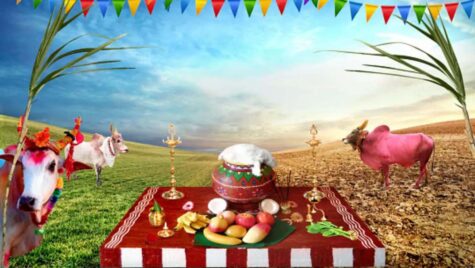

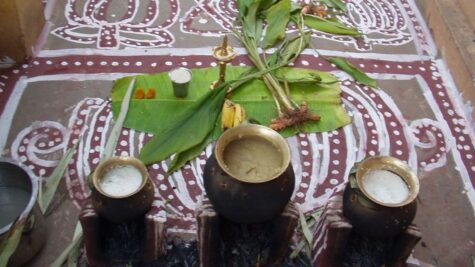
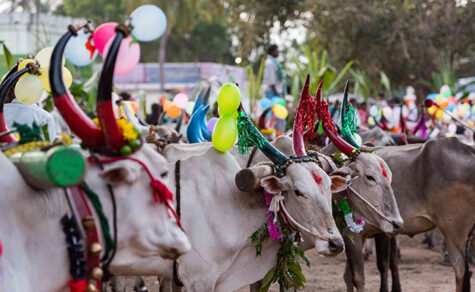
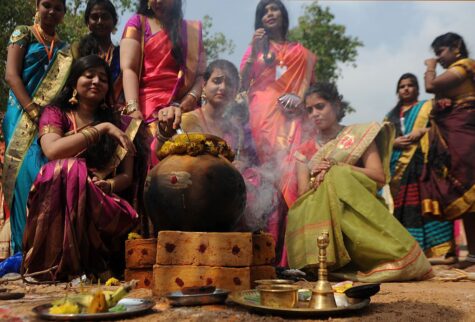
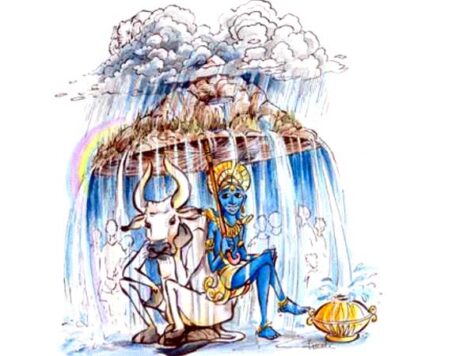
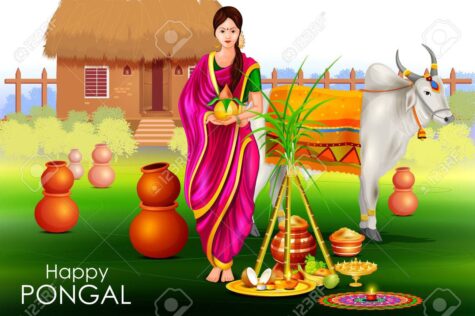
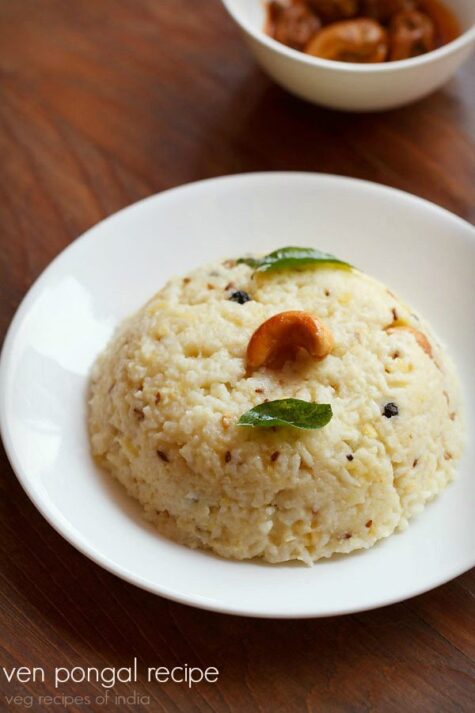



Leave a Reply